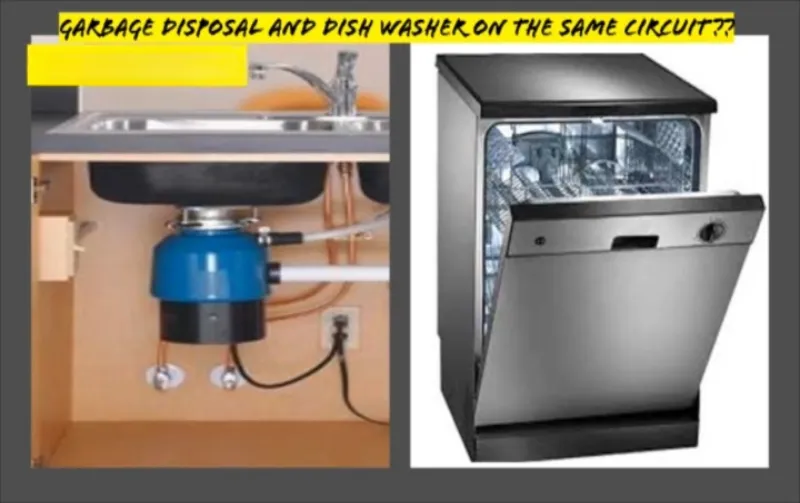A garbage disposal and dishwasher can share a circuit if the total load doesn’t exceed the circuit’s capacity. Building codes and appliance specifications should guide this decision.
Ensuring your kitchen’s electrical system is up to code is crucial for safety and efficiency.
Many homeowners wonder about the possibility of streamlining their kitchen circuits, specifically when it comes to appliances like garbage disposals and dishwashers.
These fixtures are staples in modern homes, each requiring a reliable power source to operate smoothly.
An understanding of the electrical requirements for these devices is essential when planning kitchen wiring.
The coupling of the disposal and dishwasher on the same circuit may depend on the power draw of each unit and the limitations set by local electrical codes.
Proper installation not only keeps your kitchen running without a hitch but also prevents potential hazards associated with electrical overloads.
Always consult a professional electrician to ensure that any shared circuits provide a safe and efficient power supply for your appliances.

Understanding Electrical Circuits
It’s essential to comprehend that garbage disposals and dishwashers require proper electrical circuits to operate efficiently.
These appliances can sometimes share a circuit, but the decision hinges on the total electrical load they present.
Typically, a 20-amp circuit is utilized in kitchens for these types of appliances.
When assessing the possibility of a shared circuit, you must calculate the combined electrical load.
Each appliance’s power requirement is measured in watts, and when summed up, it should not exceed the circuit’s capacity.
Let’s break down the electrical load calculation in a concise table:
| Appliance | Typical Wattage | Circuit Requirement (Amps) |
|---|---|---|
| Garbage Disposal | 450 – 850 watts | 3.75 – 7.08 amps |
| Dishwasher | 1,200 – 1,500 watts | 10 – 12.5 amps |
It’s wise to note that individual specifications will vary, so inspecting appliance manuals or consulting a licensed electrician is always recommended for accuracy.
Understanding your home’s electrical system’s intricacies ensures that both your garbage disposal and dishwasher operate safely and efficiently on the same circuit or determine if separate circuits are required.
Separate Circuit For Disposal And Dishwasher
Separate Circuit for Disposal and Dishwasher – Many homeowners ponder whether a garbage disposal and dishwasher can share the same electrical circuit.
Although it might be tempting to combine them to save on installation costs and complexity, this practice can lead to safety hazards such as overloading the circuit, which can cause tripping of the breaker or worse, electrical fires.
Adherence to building code requirements is imperative for the safety of household residents.
The National Electrical Code (NEC) often requires that these appliances be placed on dedicated circuits to accommodate their power needs and prevent electrical interference.
A qualified electrician should assess the specific capacity demands and ensure code compliance during the installation or modification of circuits for these appliances.
| Appliance | Circuit Requirement |
|---|---|
| Dishwasher | Dedicated 15-20 amp circuit |
| Garbage Disposal | Dedicated 15-20 amp circuit |
Proper Wiring For Disposal And Dishwasher
Electricians recommend separate circuits for garbage disposal and dishwasher to prevent overloading, but they can share one if necessary, adhering to local electrical codes.
It’s crucial to secure a circuit that can handle the combined load of both appliances if they must operate on the same circuit.
Always use a 20-amp circuit breaker and ensure the total amperage of both appliances does not exceed the breaker capacity.
For DIY wiring enthusiasts, safety is paramount. Double-check that the power is turned off before starting any wiring project.
Use a voltage tester to ensure no current is present. Employing heavy-duty wiring (12-2 NM cable) is also essential for handling the load.
Ground fault circuit interrupter (GFCI) protection is advisable for both appliances, offering an additional layer of safety against electrical shocks.
Do not attempt to connect multiple heavy appliances if you’re uncertain about the electrical load or your ability to safely complete the job.
Always consult with a licensed electrician to verify that any DIY wiring tasks meet local codes and safety standards.
Frequently Asked Questions Of Can Disposal And Dishwasher Be On Same Circuit
Can Both Appliances Share A Circuit?
Garbage disposals and dishwashers require significant power, so they typically need separate circuits.
What Does The Electrical Code Say?
Local electrical codes dictate whether a garbage disposal and dishwasher can share a circuit. It often depends on the power usage and local regulations.
Is It Safe To Combine Them?
Combining them on the same circuit can be safe if the total amperage doesn’t exceed the circuit breaker’s rating and it meets local codes.
How Do I Ensure Compatibility?
Consult a licensed electrician to evaluate your appliances’ power needs and ensure they can operate safely on the same circuit within code guidelines.
Conclusion
To wrap it up, it’s clear that managing your kitchen’s electrical layout demands caution.
Pairing a garbage disposal and dishwasher can save space but adherence to local codes is vital.
Consult a professional electrician to ensure a safe, efficient kitchen circuit setup.
Peace of mind and functionality can coexist with the right planning.

